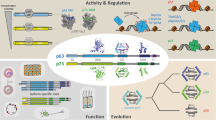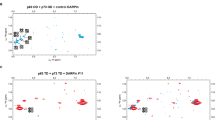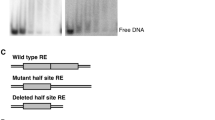Abstract
S100 proteins modulate p53 activity by interacting with its tetramerization (p53TET, residues 325–355) and transactivation (residues 1–57) domains. In this study, we characterized biophysically the binding of S100A1, S100A2, S100A4, S100A6 and S100B to homologous domains of p63 and p73 in vitro by fluorescence anisotropy, analytical ultracentrifugation and analytical gel filtration. We found that S100A1, S100A2, S100A4, S100A6 and S100B proteins bound different p63 and p73 tetramerization domain variants and naturally occurring isoforms with varying affinities in a calcium-dependent manner. Additional interactions were observed with peptides derived from the p63 and p73 N-terminal transactivation domains. Importantly, S100 proteins bound p63 and p73 with different affinities in their different oligomeric states, similarly to the differential modes of binding to p53. On the basis of our data, we hypothesize that S100 proteins regulate the oligomerization state of all three p53 family members and their isoforms, with a potential physiological relevance in developmental and disease-related processes. The regulation of the p53 family by S100 is complicated and depends on the target preference of each individual S100 protein, the concentration of the proteins and calcium, as well as the splicing variation of p63 or p73. Our results outlining the complexity of the interaction should be considered when studying the functional effects of S100 proteins in their biological context.
This is a preview of subscription content, access via your institution
Access options
Subscribe to this journal
Receive 50 print issues and online access
$259.00 per year
only $5.18 per issue
Buy this article
- Purchase on Springer Link
- Instant access to full article PDF
Prices may be subject to local taxes which are calculated during checkout






Similar content being viewed by others
References
Baudier J, Delphin C, Grunwald D, Khochbin S, Lawrence JJ . (1992). Characterization of the tumor suppressor protein p53 as a protein kinase C substrate and a S100b-binding protein. Proc Natl Acad Sci USA 89: 11627–11631.
Boldrup L, Coates PJ, Gu X, Nylander K . (2009). DeltaNp63 isoforms differentially regulate gene expression in squamous cell carcinoma: identification of Cox-2 as a novel p63 target. J Pathol 218: 428–436.
Brandt T, Petrovich M, Joerger AC, Veprintsev DB . (2009). Conservation of DNA-binding specificity and oligomerisation properties within the p53 family. BMC Genomics 10: 628.
Buckiova D, Syka J . (2009). Calbindin and S100 protein expression in the developing inner ear in mice. J Comp Neurol 513: 469–482.
Burge S, Teufel DP, Townsley FM, Freund SM, Bycroft M, Fersht AR . (2009). Molecular basis of the interactions between the p73 N terminus and p300: effects on transactivation and modulation by phosphorylation. Proc Natl Acad Sci USA 106: 3142–3147.
Chan WY, Xia CL, Dong DC, Heizmann CW, Yew DT . (2003). Differential expression of S100 proteins in the developing human hippocampus and temporal cortex. Microsc Res Tech 60: 600–613.
Danilova N, Sakamoto KM, Lin S . (2008). p53 family in development. Mech Dev 125: 919–931.
Dean B, Gray L, Scarr E . (2006). Regionally specific changes in levels of cortical S100beta in bipolar 1 disorder but not schizophrenia. Aust N Z J Psychiatry 40: 217–224.
Deyoung MP, Ellisen LW . (2007). p63 and p73 in human cancer: defining the network. Oncogene 26: 5169–5183.
Donato R . (2003). Intracellular and extracellular roles of S100 proteins. Microsc Res Tech 60: 540–551.
Dotto JE, Glusac EJ . (2006). p63 is a useful marker for cutaneous spindle cell squamous cell carcinoma. J Cutan Pathol 33: 413–417.
Fano G, Biocca S, Fulle S, Mariggio MA, Belia S, Calissano P . (1995). The S-100: a protein family in search of a function. Prog Neurobiol 46: 71–82.
Fernandez-Fernandez MR, Rutherford TJ, Fersht AR . (2008). Members of the S100 family bind p53 in two distinct ways. Protein Sci 17: 1663–1670.
Fernandez-Fernandez MR, Veprintsev DB, Fersht AR . (2005). Proteins of the S100 family regulate the oligomerization of p53 tumor suppressor. Proc Natl Acad Sci USA 102: 4735–4740.
Finlan LE, Hupp TR . (2007). p63: the phantom of the tumor suppressor. Cell Cycle 6: 1062–1071.
Grigorian M, Andresen S, Tulchinsky E, Kriajevska M, Carlberg C, Kruse C et al. (2001). Tumor suppressor p53 protein is a new target for the metastasis-associated Mts1/S100A4 protein: functional consequences of their interaction. J Biol Chem 276: 22699–22708.
Hibi K, Trink B, Patturajan M, Westra WH, Caballero OL, Hill DE et al. (2000). AIS is an oncogene amplified in squamous cell carcinoma. Proc Natl Acad Sci USA 97: 5462–5467.
Ilg EC, Schafer BW, Heizmann CW . (1996). Expression pattern of S100 calcium-binding proteins in human tumors. Int J Cancer 68: 325–332.
Joerger AC, Fersht AR . (2007). Structure-function-rescue: the diverse nature of common p53 cancer mutants. Oncogene 26: 2226–2242.
Joerger AC, Rajagopalan S, Natan E, Veprintsev DB, Robinson CV, Fersht AR . (2009). Structural evolution of p53, p63, and p73: implication for heterotetramer formation. Proc Natl Acad Sci USA 106: 17705–17710.
Kirschner RD, Sanger K, Muller GA, Engeland K . (2008). Transcriptional activation of the tumor suppressor and differentiation gene S100A2 by a novel p63-binding site. Nucleic Acids Res 36: 2969–2980.
Langenbacher A, Chen JN . (2008). Calcium signaling: a common thread in vertebrate left-right axis development. Dev Dyn 237: 3491–3496.
Lapi E, Iovino A, Fontemaggi G, Soliera AR, Iacovelli S, Sacchi A et al. (2006). S100A2 gene is a direct transcriptional target of p53 homologues during keratinocyte differentiation. Oncogene 25: 3628–3637.
Lauriola L, Michetti F, Maggiano N, Galli J, Cadoni G, Schafer BW et al. (2000). Prognostic significance of the Ca(2+) binding protein S100A2 in laryngeal squamous-cell carcinoma. Int J Cancer 89: 345–349.
Lin J, Blake M, Tang C, Zimmer D, Rustandi RR, Weber DJ et al. (2001). Inhibition of p53 transcriptional activity by the S100B calcium-binding protein. J Biol Chem 276: 35037–35041.
Lin J, Yang Q, Yan Z, Markowitz J, Wilder PT, Carrier F et al. (2004). Inhibiting S100B restores p53 levels in primary malignant melanoma cancer cells. J Biol Chem 279: 34071–34077.
MacGregor IK, Anderson AL, Laue TM . (2004). Fluorescence detection for the XLI analytical ultracentrifuge. Biophys Chem 108: 165–185.
Melino G, Lu X, Gasco M, Crook T, Knight RA . (2003). Functional regulation of p73 and p63: development and cancer. Trends Biochem Sci 28: 663–670.
Mills AA, Zheng B, Wang XJ, Vogel H, Roop DR, Bradley A . (1999). p63 is a p53 homologue required for limb and epidermal morphogenesis. Nature 398: 708–713.
Moll UM, Slade N . (2004). p63 and p73: roles in development and tumor formation. Mol Cancer Res 2: 371–386.
Mrak RE, Griffinbc WS . (2001). The role of activated astrocytes and of the neurotrophic cytokine S100B in the pathogenesis of Alzheimer's disease. Neurobiol Aging 22: 915–922.
Mueller A, Schafer BW, Ferrari S, Weibel M, Makek M, Hochli M et al. (2005). The calcium-binding protein S100A2 interacts with p53 and modulates its transcriptional activity. J Biol Chem 280: 29186–29193.
Pelosi G, Pasini F, Olsen Stenholm C, Pastorino U, Maisonneuve P, Sonzogni A et al. (2002). p63 immunoreactivity in lung cancer: yet another player in the development of squamous cell carcinomas? J Pathol 198: 100–109.
Pruneri G, Pignataro L, Manzotti M, Carboni N, Ronchetti D, Neri A et al. (2002). p63 in laryngeal squamous cell carcinoma: evidence for a role of TA-p63 down-regulation in tumorigenesis and lack of prognostic implications of p63 immunoreactivity. Lab Invest 82: 1327–1334.
Rajagopalan S, Jaulent AM, Wells M, Veprintsev DB, Fersht AR . (2008). 14–3–3 activation of DNA binding of p53 by enhancing its association into tetramers. Nucleic Acids Res 36: 5983–5991.
Rosenbluth JM, Pietenpol JA . (2008). The jury is in: p73 is a tumor suppressor after all. Genes Dev 22: 2591–2595.
Rustandi RR, Baldisseri DM, Weber DJ . (2000). Structure of the negative regulatory domain of p53 bound to S100B(betabeta). Nat Struct Biol 7: 570–574.
Salama I, Malone PS, Mihaimeed F, Jones JL . (2008). A review of the S100 proteins in cancer. Eur J Surg Oncol 34: 357–364.
Santamaria-Kisiel L, Rintala-Dempsey AC, Shaw GS . (2006). Calcium-dependent and -independent interactions of the S100 protein family. Biochem J 396: 201–214.
Schuck P . (2000). Size-distribution analysis of macromolecules by sedimentation velocity ultracentrifugation and lamm equation modeling. Biophys J 78: 1606–1619.
Scotto C, Deloulme JC, Rousseau D, Chambaz E, Baudier J . (1998). Calcium and S100B regulation of p53-dependent cell growth arrest and apoptosis. Mol Cell Biol 18: 4272–4281.
Scotto C, Delphin C, Deloulme JC, Baudier J . (1999). Concerted regulation of wild-type p53 nuclear accumulation and activation by S100B and calcium-dependent protein kinase C. Mol Cell Biol 19: 7168–7180.
Scoumanne A, Harms KL, Chen X . (2005). Structural basis for gene activation by p53 family members. Cancer Biol Ther 4: 1178–1185.
Sedaghat F, Notopoulos A . (2008). S100 protein family and its application in clinical practice. Hippokratia 12: 198–204.
Serber Z, Lai HC, Yang A, Ou HD, Sigal MS, Kelly AE et al. (2002). A C-terminal inhibitory domain controls the activity of p63 by an intramolecular mechanism. Mol Cell Biol 22: 8601–8611.
Slomnicki LP, Nawrot B, Lesniak W . (2009). S100A6 binds p53 and affects its activity. Int J Biochem Cell Biol 41: 784–790.
Teufel DP, Freund SM, Bycroft M, Fersht AR . (2007). Four domains of p300 each bind tightly to a sequence spanning both transactivation subdomains of p53. Proc Natl Acad Sci USA 104: 7009–7014.
van Dieck J, Fernandez-Fernandez MR, Veprintsev DB, Fersht AR . (2009). Modulation of the oligomerization state of p53 by differential binding of proteins of the S100 family to p53 monomers and tetramers. J Biol Chem 284: 13804–13811.
Vigliano FA, Bermudez R, Nieto JM, Quiroga MI . (2009). Development of rodlet cells in the gut of turbot (Psetta maxima L.): relationship between their morphology and S100 protein immunoreactivity. Fish Shellfish Immunol 26: 146–153.
Vilgelm A, El-Rifai W, Zaika A . (2008). Therapeutic prospects for p73 and p63: rising from the shadow of p53. Drug Resist Update 11: 152–163.
Whitaker M . (2008). Calcium signalling in early embryos. Philos Trans R Soc Lond B Biol Sci 363: 1401–1418.
Yamaguchi K, Wu L, Caballero OL, Hibi K, Trink B, Resto V et al. (2000). Frequent gain of the p40/p51/p63 gene locus in primary head and neck squamous cell carcinoma. Int J Cancer 86: 684–689.
Yang A, Schweitzer R, Sun D, Kaghad M, Walker N, Bronson RT et al. (1999). p63 is essential for regenerative proliferation in limb, craniofacial and epithelial development. Nature 398: 714–718.
Yang A, Walker N, Bronson R, Kaghad M, Oosterwegel M, Bonnin J et al. (2000). p73-deficient mice have neurological, pheromonal and inflammatory defects but lack spontaneous tumours. Nature 404: 99–103.
Zimmer DB, Cornwall EH, Landar A, Song W . (1995). The S100 protein family: history, function, and expression. Brain Res Bull 37: 417–429.
Zimmer DB, Wright Sadosky P, Weber DJ . (2003). Molecular mechanisms of S100-target protein interactions. Microsc Res Tech 60: 552–559.
Acknowledgements
We thank Karoly von Glos for technical assistance with peptide synthesis and Dr Maria R Fernandez-Fernandez for critical reading of the paper.
Author information
Authors and Affiliations
Corresponding author
Rights and permissions
About this article
Cite this article
van Dieck, J., Brandt, T., Teufel, D. et al. Molecular basis of S100 proteins interacting with the p53 homologs p63 and p73. Oncogene 29, 2024–2035 (2010). https://doi.org/10.1038/onc.2009.490
Received:
Revised:
Accepted:
Published:
Issue Date:
DOI: https://doi.org/10.1038/onc.2009.490
Keywords
This article is cited by
-
S100A6: molecular function and biomarker role
Biomarker Research (2023)
-
The interaction between S100A2 and KPNA2 mediates NFYA nuclear import and is a novel therapeutic target for colorectal cancer metastasis
Oncogene (2022)
-
The p53-S100A2 Positive Feedback Loop Negatively Regulates Epithelialization in Cutaneous Wound Healing
Scientific Reports (2018)
-
Suppression of islet homeostasis protein thwarts diabetes mellitus progression
Laboratory Investigation (2017)
-
Inhibition of S100A6 induces GVL effects in MLL/AF4-positive ALL in human PBMC-SCID mice
Bone Marrow Transplantation (2014)



